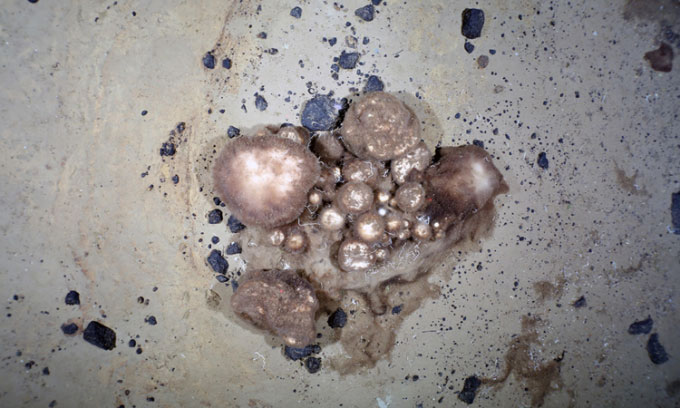Thousands of sponges thrive in an ancient underwater volcano beneath the Arctic Ocean by absorbing abundant compounds from long-dead marine organisms.
Scientists have discovered a spongy garden at Langseth Ridge, part of an ancient underwater volcano in the Central Arctic Ocean, at depths of 500 – 600 meters, where the temperature is just above freezing. Specifically, they found thousands of sponges covering an area of 15 km2.
In some nutrient-scarce deep-sea regions, benthic ecosystems often concentrate around hydrothermal vents. These vents can provide heat and food; however, volcanic activity in this underwater mountain ceased thousands of years ago. There are also no strong currents bringing food to the sponges from above or below.

The average age of the sponge garden is 300, with some even older. (Photo: Alfred-Wegener-Institut/PS101 AWI OFOS system/Antje Boetius).
However, the sponges have found a rich and plentiful food source: dissolved compounds from a graveyard of tube worms and long-dead bivalves. They digest these compounds with the help of symbiotic bacteria.
Scientists used a network of cameras and sensors called “Deep-Sea Measurement and Observation System” to capture video, take photos, and collect other data about the sponge garden. They also collected sponge and environmental samples using a remotely operated submersible named “Nereid Under-Ice”. The new research was published in the journal Nature Communications on February 8.
Among the thousands of sponges gathered around the peaks of the underwater volcano, many have grown to a very large size with diameters of up to 1 meter, according to Teresa Morganti, a postdoctoral researcher at the Max Planck Institute and the lead author of the study. Many sponges are also actively reproducing.
Below the sponge garden, the research team found a thick layer of biomass primarily composed of tubes left by the marine worms. These worms died when the underwater volcano ceased activity about 2,000 – 3,000 years ago.
Fossil traces of sponges indicate where they used to forage before “settling” above the biomass layer. Many individual sponges are at least 300 years old and host diverse microorganisms. Bacteria from the phylum Chloroflexi may play a crucial role in breaking down fossilized tube worms and releasing dissolved organic matter to feed the sponges.
If sponges have been here for centuries and there are currently thousands of individuals, is their food supply at risk of depletion? Morganti suggests that the answer is likely no, as the metabolic rate of sponges is particularly slow.
“These are large individuals living in the Central Arctic Ocean, where the temperatures are very cold, so their metabolism is generally extremely low. They do not quickly consume this food source. Therefore, I believe they still have plenty of food,” she explains.
However, even if the food supply does not quickly deplete, climate change could pose more immediate threats to the survival of the sponges. The sea surface above Langseth Ridge is often covered with ice. But as the Arctic warms and the sea ice melts, more nutrients will wash from the surface down to the underwater mountains below. Morganti noted that if deep-sea food becomes more abundant, other marine organisms may move down there and disrupt the sponges’ deep-sea habitat.


















































